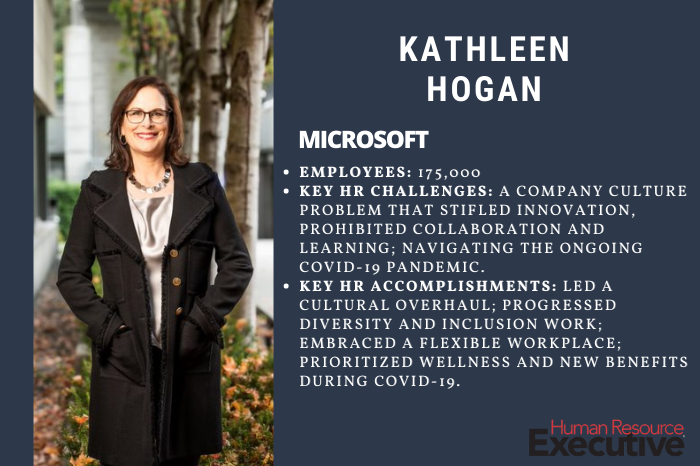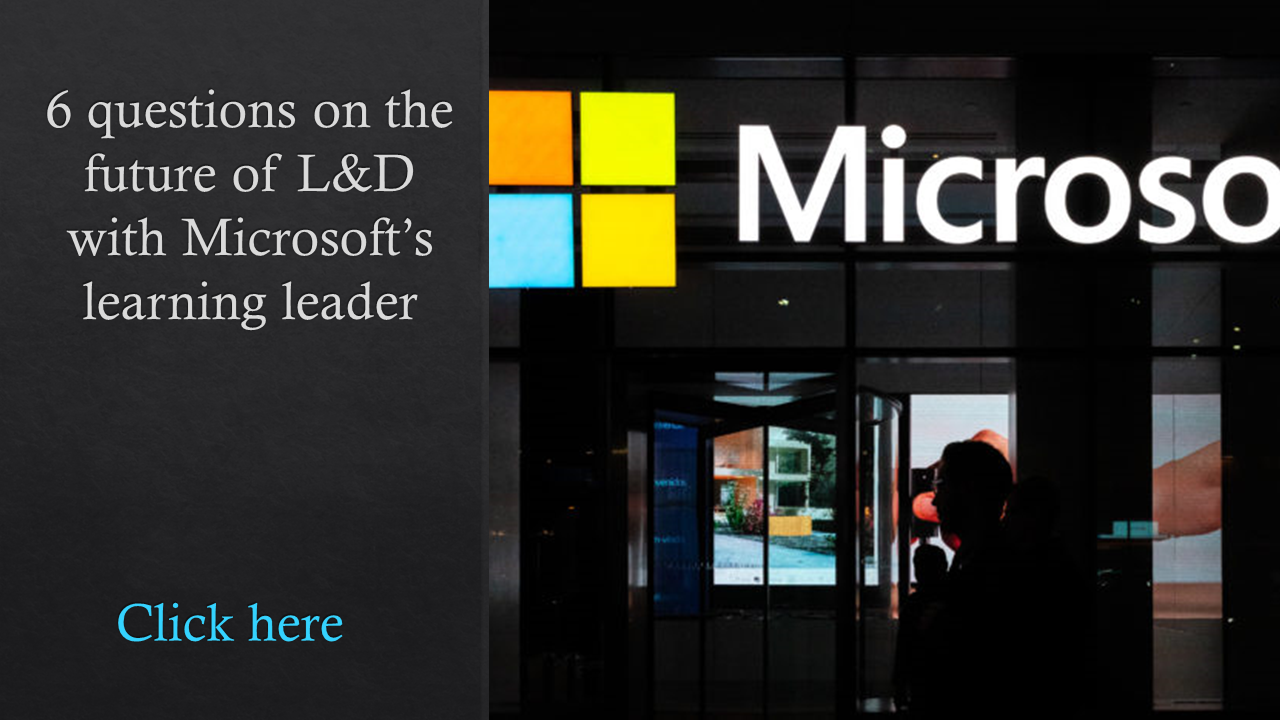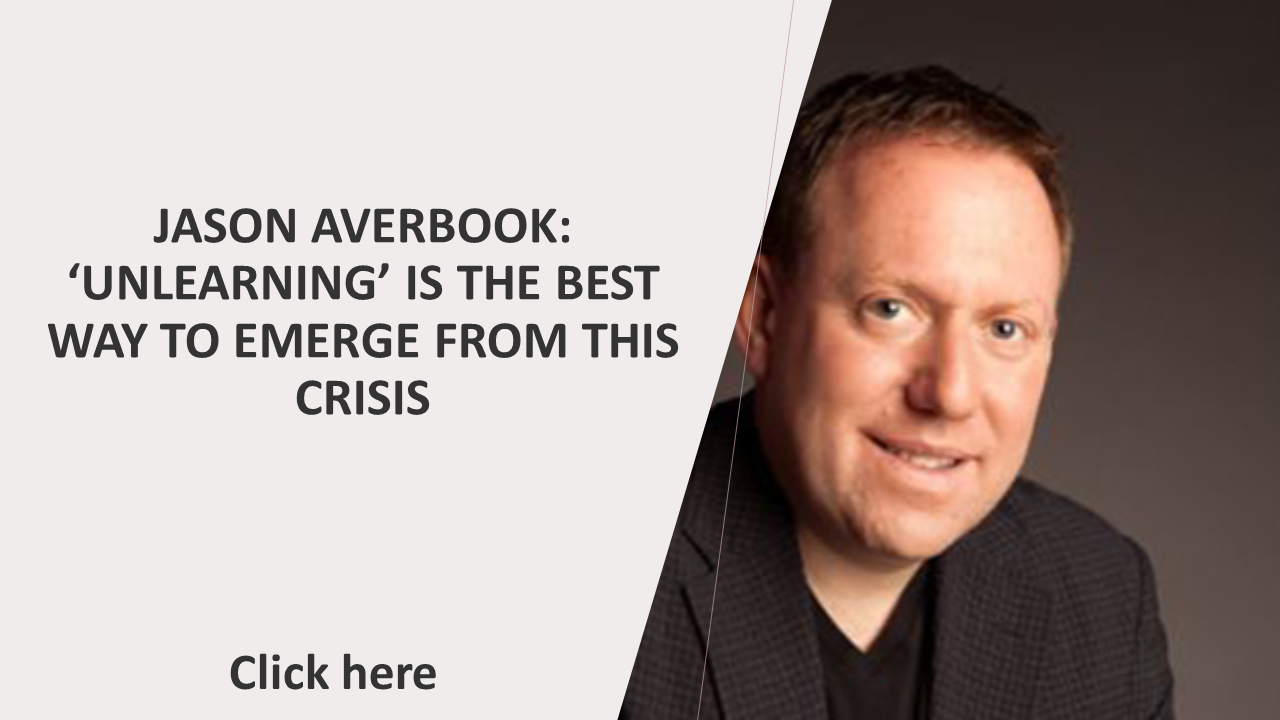In the late aughts and early 2010s, as other tech firms began outpacing it in mobile computing, social media and gaming, Microsoft was in danger of losing its status as one of the world’s most innovative companies. And the organization’s huge culture problem, which was wreaking havoc internally, was mostly to blame.
Employees were deeply competitive with one another. Workers were critical of themselves and of each other. There were internal political battles. Departments were siloed. A former employee’s cartoon drawing of the company’s org chart–depicting the departments pointing guns at each other–was hard to ignore.
“Satya [Nadella, who became Microsoft CEO in 2014] netted it out the best when he said we had become a bunch of know-it-alls, when we really needed to be a bunch of learn-it-alls,” says Kathleen Hogan, executive vice president, human resources, and chief people officer at Microsoft and HRE’s 2021 HR Executive of the Year.

What she describes as Microsoft’s “fixed mindset” was preventing it from seeing trends, from finding creative solutions, from being inclusive. “All of that was getting in the way of us being able to innovate to the next level. It was getting in the way of us being successful,” Hogan says.
So, in 2015, the company decided to fix all that.
The tech giant wanted to shift its focus to a culture of learning. It wanted to create a safe space where employees could embrace failure, learn from one another, collaborate, innovate. Become a place where people wanted to work. In short, the firm at the apogee of technology needed to become more human.
See also: Your culture has changed. Here’s how to shape it for the future
Hogan, who joined Microsoft in 2003 as chief operating officer of sales and became HR head in late 2014, was asked by Nadella to help lead the cultural transformation. She took to the task with intent, for nine months leading focus groups, talking to companies, reading about culture, meeting with employees, connecting with leaders, organizing a “culture cabinet” and conferring with experts on the topic. Not only were Hogan and Microsoft searching for how they wanted to define the company’s culture, but they also were searching for what they did not want to change–including big, bold ambitions and a spirit of giving, a la Microsoft co-founder and philanthropist Bill Gates, whose Bill and Melinda Gates Foundation, launched in 2000, is now one of the largest charitable foundations in the world.
One of the key shifts was changing to a growth mindset, promoting learning and coaching that empowers employees. Among other aspects of its culture, it aimed to be diverse and inclusive, customer-obsessed and to come together as “one Microsoft.”
Hogan’s, and Microsoft’s, efforts paid off handsomely: Now, 95% of employees say they feel proud to work at Microsoft; representation of Black, Hispanic and Latinx employees and leaders at the company has grown for six consecutive years; its growth mindset mentality has enabled the company and its workers to succeed during the pandemic. Overall, Microsoft’s relevance–and profits–exploded.
And those efforts, along with her leadership during COVID-19 and collaborative spirit over the years, helped earn Hogan the title of 2021 HR Executive of the Year.
“What Satya and Kathleen together engineered over the last several years has been remarkable,” says Kevin Oakes, CEO and co-founder of research firm i4cp and author of Culture Renovation. “It’s hard to stress enough how dramatic a shift there’s been at the organization. And it’s a blueprint that I think organizations of any size in any industry can follow.”
 Culture is often a buzzword for organizations, many of whom throw the term around to lure potential talent. But true, deep-rooted company culture that drives an organization and what it stands for is hard to come by. Even more rare is an organization’s ability to successfully transform its culture, Oakes says. “It is really hard to change. Our research has shown that only 15% of companies that set out to renovate their culture actually succeed. The rest have some sort of failure involved.”
Culture is often a buzzword for organizations, many of whom throw the term around to lure potential talent. But true, deep-rooted company culture that drives an organization and what it stands for is hard to come by. Even more rare is an organization’s ability to successfully transform its culture, Oakes says. “It is really hard to change. Our research has shown that only 15% of companies that set out to renovate their culture actually succeed. The rest have some sort of failure involved.”
Microsoft, though, is a model of a company that did it and did it well. But even now, Hogan admits Microsoft’s cultural journey isn’t over. Success isn’t declared–not even by rankings on Best Places to Work lists or a dramatic rise in the company’s valuation that was boosted to more than $2 trillion since its cultural transformation. In 2015, its valuation hovered around $350 billion. (Microsoft now is the second most valuable company in the world, behind Apple). Instead, culture is continually worked on, and something workers can lean on during tough times.
“It’s always driving us. It’s about taking steps to close the gap between what we’ve asserted for all 175,000 employees and what all 175,000 employees experience on any given day,” Hogan says. “I think that gap is closing, but it’s not perfection.”
A year of change
Microsoft’s focus on culture and people gained new importance in the age of COVID-19, when the company, like all others, was dealt a new and unexpected hand. The pandemic has undeniably wreaked havoc on employees. Add to that stress over climate change, racial injustice and more, and employees of the Redmond, Wash.-based tech giant were reeling from personal and professional challenges.
“We saw in our data that our people are overwhelmed. People are stressed; people have anxiety within the level of uncertainty happening in the world,” Hogan explains on a Microsoft Teams call–naturally–from her home office in Redmond. “There are just so many different things happening … and profound heartache about what we were seeing in the news.”
Like other leaders who have embraced rallying cries of empathy and flexibility over the past year-and-a-half, Hogan took a hard look at what the company could do to help employees stay healthy and sane–and remain innovative, productive and present on the job.
Related: Here’s how HR can lead a ‘culture renovation’
Gleaning insights from Microsoft’s daily pulse survey of workers, which among other things helped identify specific pain points, she leaned on innovative and game-changing benefits to help, including a 12-week parental paid leave policy that allowed parents to take off time as schools and daycares closed down due to COVID. Under her leadership, Microsoft also gave $1,500 bonuses to many employees; introduced five additional paid days off, dubbed “wellness days,” earlier this year so employees could rest and recharge; and expanded backup childcare. And importantly, she accelerated the company’s mental health efforts, not only reminding employees about available resources, but also encouraging them to use them. “It really has all been about trying to understand what our employees need,” Hogan says.
Related: Join us to honor Kathleen Hogan on Oct. 21
And, of course, the company leveraged its culture, which Hogan credits as essential to getting through hard times. Part of that culture was enabling managers to become better leaders–a goal made ever more vital during a pandemic when leadership is demanded. Every manager goes through required training to help them model, coach and care for their teams. That paid off, as Microsoft’s surveys revealed all-time highs in some of the questions it had been asking employees about their managers for many years: For instance, confidence in an employee’s immediate manager reached 90%, and 96% of employees said their manager treats them with respect/dignity. Those are impressive stats made even more vital for a company from which other employers often try to poach talent–and made more important during the Great Resignation, as waves of employees are quitting and many more are looking to leave their current jobs.
Leadership in action
As challenging as COVID-19 has been for Microsoft, CEO Nadella says Hogan’s leadership strengths were only amplified by the trials of the pandemic.
“This includes empathy for our employees and their families and decisive action to provide aid and ensure their wellbeing, consistently putting people first in decision-making, exhibiting and encouraging a growth mindset, and illuminating the critical importance of the strong partnership required between HR, IT and the rest of company leadership to deliver an optimal employee experience,” he tells HRE.
 The pandemic has no shortage of lessons in the workplace: the feasibility of remote work, the importance of wellbeing, mental health, flexibility. That’s all true for Microsoft, but the biggest way the company has changed because of COVID-19, Hogan says, is by becoming more human–developing the kind of understanding that happens when kids or pets crash video meetings, when co-workers get a glimpse of each other’s homes and when people bond over crisis and turmoil and angst and death.
The pandemic has no shortage of lessons in the workplace: the feasibility of remote work, the importance of wellbeing, mental health, flexibility. That’s all true for Microsoft, but the biggest way the company has changed because of COVID-19, Hogan says, is by becoming more human–developing the kind of understanding that happens when kids or pets crash video meetings, when co-workers get a glimpse of each other’s homes and when people bond over crisis and turmoil and angst and death.
“I like to think that with our focus on culture, we were already becoming human and empathetic,” Hogan says. “But when you are going through a crisis, and you have to bond together, and people are seeing each other in their home environment, navigating all the different things that they’ve navigated … it makes the connections more human, more profound.”
A new way of working
Although tech is its focus, Microsoft surprisingly wasn’t a company exactly ready for the forced massive experiment of remote work. (Its envious 500-acre main campus, after all, boasts treehouses, dozens of places to eat, shops, basketball courts, a hair salon and much more for its employees.) When work arrangements changed for most of the firm’s employees last March, its cultural shift, again, prepared the company for the change.
“[Before COVID,] people would have said, €˜It’s impossible.’ They would have said, €˜I never can interview virtually; it’s important that I meet everybody in person and hire them.’ Well, challenge that fixed mindset, because we’re in a new world, and we have to hire virtually,” Hogan says. “I think, on some level, the fact that we’ve branded our culture as a growth mindset was super helpful. It was less about COVID creating the culture versus relying on the culture and accelerating the culture.”
Related: Hybrid, remote, on-site? Employees have weighed in
Unsurprisingly, the company leaned on its own products to help connect and make remote work work. Microsoft Teams allowed for video calls, quick chats, even emojis and applause to help coworkers connect. (“Can you imagine if we had to do [all of that] over a speakerphone?” Hogan says.) Nadella and other leaders used Microsoft’s Yammer as a channel to engage with employees, listening to and learning what’s on their minds. Overall, Microsoft onboarded some 25,000 new workers remotely over the past 18 months.
All of that remains important as the company largely continues to embrace remote and hybrid working. (Microsoft recently announced it was nixing its October date to fully reopen offices because of concerns about the Delta variant, and it won’t be predicting a new date at this point.) Like most companies, it plans to keep workers remote in some capacity going forward. Hogan says for most roles, Microsoft now views working from home part of the time as standard.
 “One of the key things coming out of the pandemic will be teams being much more intentional about how they work so that they can have more flexibility,” she says. “Do we all have to be in the office five days? Or if we’re all going to be in the office five days a week, can we all be agreed that the meetings are going to be in the morning, so then people can plan and have flexibility in the afternoon? All of that is happening now.”
“One of the key things coming out of the pandemic will be teams being much more intentional about how they work so that they can have more flexibility,” she says. “Do we all have to be in the office five days? Or if we’re all going to be in the office five days a week, can we all be agreed that the meetings are going to be in the morning, so then people can plan and have flexibility in the afternoon? All of that is happening now.”
Unconventional path
Although she is now the HR head at one of the most recognizable companies in the world, Hogan didn’t set out to work in human resources. A math major at Harvard, she started as a software developer at Oracle, then moved into consulting at McKinsey & Company before joining Microsoft. Although an untraditional path, it was one that helped ready her for one of the most important positions in one of the world’s most powerful companies.
“She’s very thoughtful around people issues. Her background with consulting gives her the ability to be a true consultant, to listen and try a solution,” says Tracy Keogh, chief people officer of private equity firm Great Hill Partners and former CHRO of HP. Keogh is one of Hogan’s frequent collaborators in the HR industry and was the 2015 HR Executive of the Year. “If it doesn’t work, then she’ll evolve that solution until it’s the right thing for the organization. And that’s totally part of having a growth mindset.”
Hogan admits her relatively recent move to HR sometimes presents a learning curve–which makes being surrounded by a smart HR team and an “empathetic and exceptional” CEO like Nadella paramount. Coming from outside of HR allowed her to arrive with an open mindset and prompted her to lean on other HR leaders who were doing it longer for guidance and collaboration. Seven years into her role, she continues to do that, and in the process has become one of the profession’s most vocal leaders and cheerleaders.
Hogan often talks to other CHROs about the biggest issues–from COVID to racial justice to diversity and inclusion–learning and looking for collective solutions. And in 2019, Hogan initiated Microsoft’s CHRO Summit, which convenes global leaders to discuss the challenges, opportunities and changing landscape CHROs are facing. She also regularly uses her LinkedIn platform to provide expertise and insights on important topics impacting the HR profession. It was there she launched her #PeopleTalk video series in which she engages in topical discussions with industry leaders and CHROs.
That collaborative spirit has been especially important in the pandemic era, which most company leaders contend is the most difficult period of their careers.
“There’s the sense of community among the CHROs of all of us trying to help each other navigate a lot of different challenges, trying to deliver great experiences,” Hogan says. “I think we’re all partnered to try to work together.”
For Hogan, the last year also has been a reminder of the important role of employee benefits, flexibility and employer support. And it’s been an eye-opener about the profound and purposeful role HR can have.
Hogan admits in her quest for the best possible company culture, she often is mired in the details, worried about not meeting expectations, feeling urgency over closing the gap. The past year-and-a-half, though, has allowed her to step back to see how all her efforts have worked together and how much impact they can have.
“I always felt that there was deep purpose in this role. Some days you feel it more than others; some days you have to zoom out and remind yourself that there’s deep purpose in the ability to help other people and be a servant leader,” she says. “At the end of the day, people are your greatest asset. It’s the people and the talent and their ability–their physical and mental health and their ability to feel included. All of that is what contributes ultimately to our ability to innovate.”



